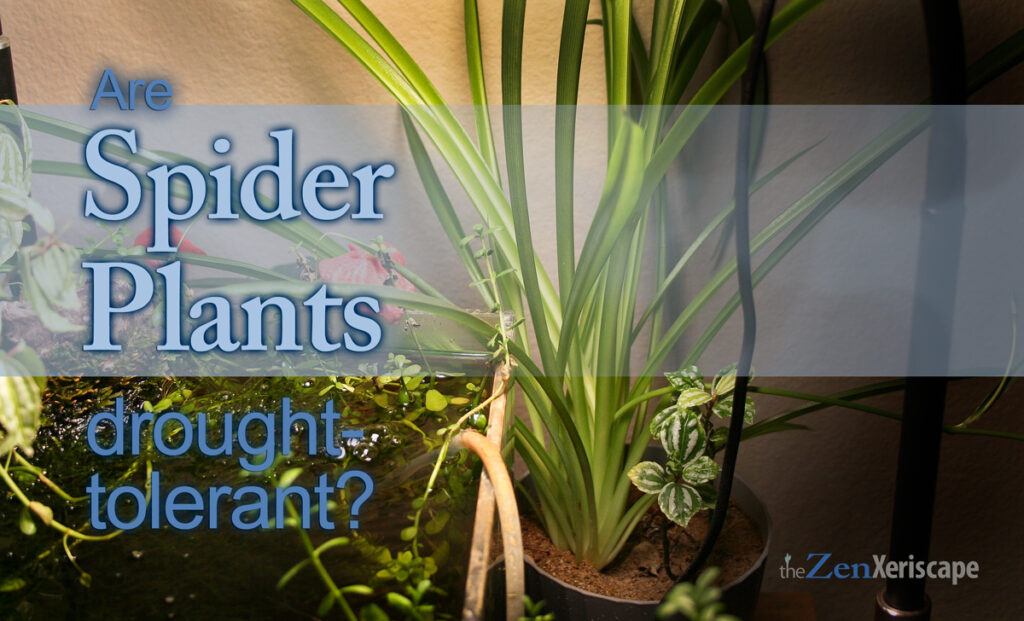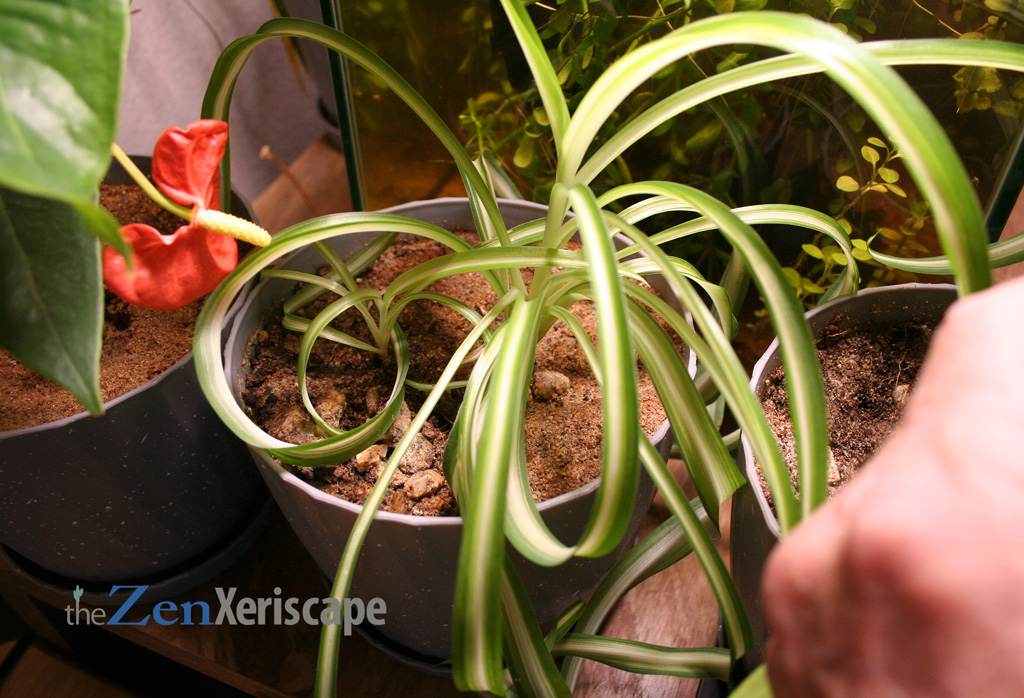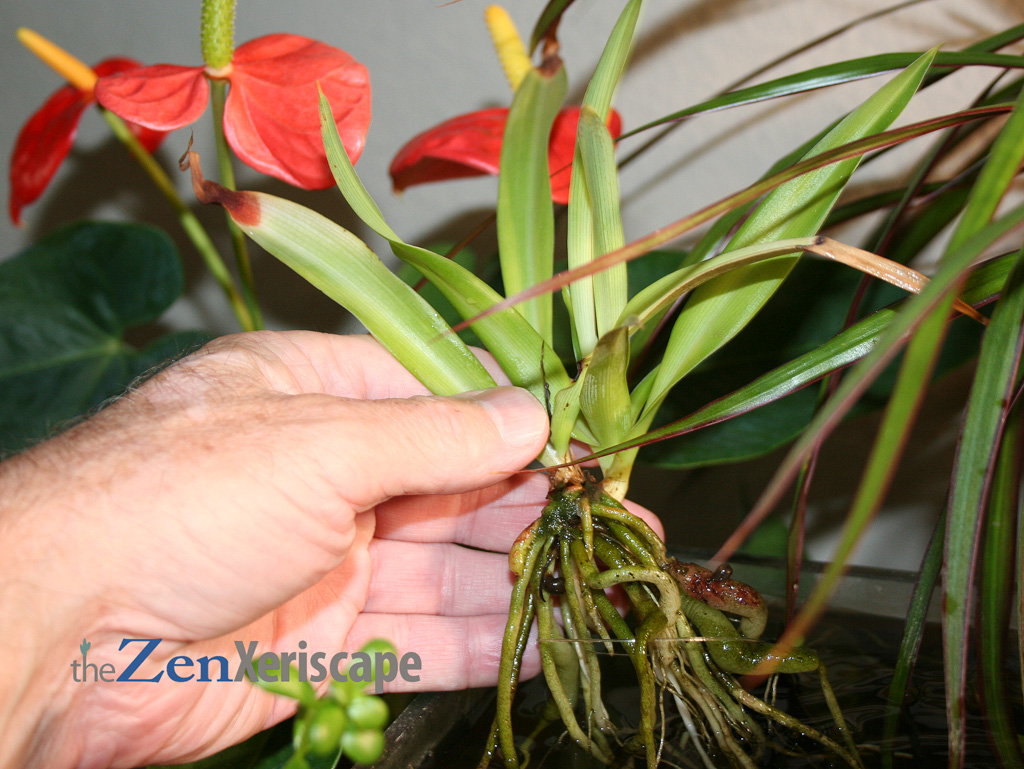To me, spider plants add a tropical vibe to indoor living spaces. But, are they really drought-tolerant plants that thrive with only a little water? So, here are my thoughts: are spider plants drought-tolerant?

But, does that mean that
spider plants are drought-tolerant?
Photo by Doug Martin
Spider plant care guidelines
But first, let’s look at the guidelines to care for spider plants. Then, we should have our answer.
Use well-draining soil
I use soil specially prepared for succulents or cactus plants.
Use a container with holes for drainage
When potting your spider plant, always use a container with drainage holes. In fact, that’s true also if you’re planting your spider plant outside.
Of course, here in Phoenix, Arizona, spider plants would not do very well outside in our summer heat. However, they might do well as an annual plant during the fall, winter, and spring months.
Indirect bright light is best
Indoors, some sun (for a few hours) is okay, but bright, indirect light is best. In my case, I grow my spider plants around a heavily planted aquarium with aquatic plants.
There, I have them under grow lights that are primarily aimed at the aquatic plants, but also provide ample light for the spider plants. The grow lights don’t burn their leaves like too much direct sunlight would.
I also have a couple of spider plant varieties that are in a bright room that receives almost no direct sunlight. They do well with indirect lighting.

is under a grow light.
I only water once-a-week,
and it remains lush.
Photo by Doug Martin
A few Amazon vendors offer spider plants for sale. That’s where I bought all of my spider plants. In general, I’ve had excellent luck ordering plants through Amazon, but be sure to check the vendor’s reputation before ordering. (As an Amazon Associate, I earn a commission from qualifying purchases.)
Watering schedules
In both cases, I only water all my indoor spider plants once a week. If you’re lucky enough to be able to grow your spider plants outside year-round, only water when the top one-or-two inches of the soil is dry.
After watering, the soil in my container-bound spider plants will become completely dry throughout the week. Despite the dry soil, their leaves remain lush with no brown edges. But, I don’t think they would do well if I went longer than a week without watering them.
What kind of water should I use?
I have only watered my spider plants using conditioned water from my aquariums, which house fish and shrimp. That water has already been dechlorinated and aged.
While it’s not necessary to use dechlorinated water, look out for brown leaf tips or edges. Those symptoms can be caused by chlorine, fluoride, salts, or other chemicals that might be found in your tap water.
If you do get those symptoms, try aging your water in a bucket. Before I add water to my aquariums, I always age it in a separate large bucket prior to using.
Should you age your water in a separate bucket
Chlorine is a volatile compound, so it will evaporate when exposed to air. So, aging in a bucket will eliminate the chlorine from your tap water.
…or, continue using untreated tap water
Of course, if your spider plants still have leaves that look lush, without brown tips or edges, continue using untreated tap water.
Fertilizer
Add a balanced fertilizer once or twice a month during the growing season. I’ve never fertilized my spider plants, but I do use water from my aquariums. So, I think they’re getting plenty of nutrients from that water source.
Best temperatures for Spider Plants
Spider plants enjoy moderate room temperatures of about 50-90 degrees fahrenheit (10-30 degrees C). It’s a hot August right now at my place in Phoenix, Arizona, and I have my room temps set for 81 degrees during the day and 79 degrees at night.
If you’re cultivating spider plants outside, they will do best in USDA hardiness zones of 9-to-11. However, I’m in zone 9b in southern Arizona, and there is no way that a spider plant will survive our summers outside. At least I don’t think so.
But, the beauty of growing these beauties in a container is that you can bring them inside when the weather is unpleasant for them.
Humidity
Generally, spider plants enjoy moderate to higher humidity. However, here in my southern Arizona home, the humidity is very low during the fall, winter, and spring months, and my spider plants still look lush.
At times, low humidity might cause these plants to get brown on the sides and tips of their leaves.

in the aquarium (roots only). At first,
the roots grew quickly, but as time went by,
the plants themselves suffered.
They did not grow well with their roots wet.
Photo by Doug Martin
Get Prime! (As an Amazon Associate, I earn a commission from qualifying purchases.)
So, are spider plants drought-tolerant?
Yes, I think they are drought-tolerant (to a degree). I only water my spider plants deeply once-a-week. During the following days, the soil quickly dries out, especially if they have a well-developed root system.
But, they are not as drought tolerant as my aloe veras or many of my other succulents.
Please share your experiences with spider plants and your watering techniques. I was always curious how spider plants did in the southeastern United States. In those zones, I suspect that many people grow these plants outside year-round.
So, what are your experiences? Are spider plants drought-tolerant? Please share your thoughts in the comments section below!
Content and photos by Doug Martin and The Zen Xeriscape

